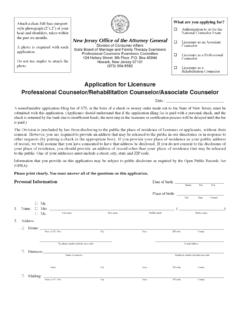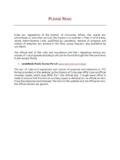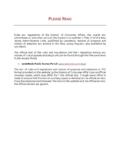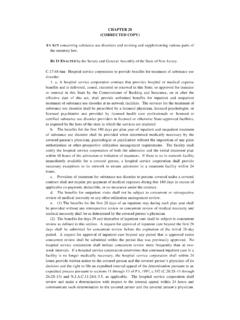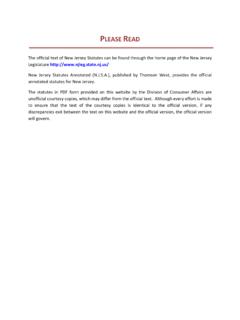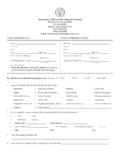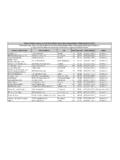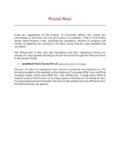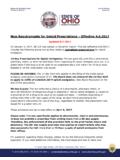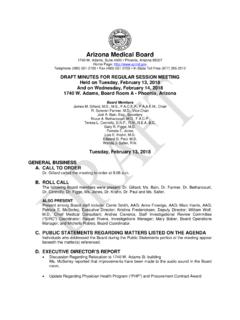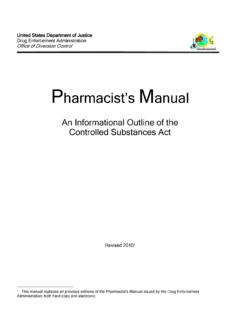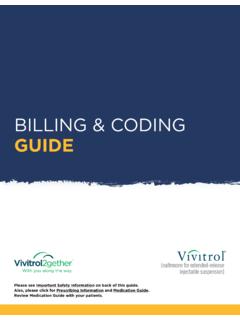Transcription of PLEASE READ - New Jersey Division of Consumer …
1 PLEASE read Rules and regulations of the Division of Consumer Affairs, the boards and committees in, and other units of, the Division are codified in Title 13 of the New Jersey Administrative Code, published by LexisNexis. Notices of proposal and notices of adoption are printed in the New Jersey Register, also published by LexisNexis. The official text of the rules and regulations and their regulatory history and notices of rule proposals and adoptions can be found through the free LexisNexis Public Access Portal. LexisNexis Public Access Portal: The text of rules and regulations and notices of proposal and adoptions in PDF format provided on this website by the Division of Consumer Affairs are unofficial courtesy copies, which may differ from the official text.
2 Though every effort is made to ensure that the text of courtesy copies is identical to the official version, if any discrepancies exist between the text on this website and the official version, the official version will govern. Chapter 35 - Rule 13 Page 2 of 6 Last Revision Date: 5/01/2017 13 LIMITATIONS ON PRESCRIBING, ADMINISTERING, OR DISPENSING OF CONTROLLED DANGEROUS SUBSTANCES; SPECIAL REQUIREMENTS FOR MANAGEMENT OF ACUTE AND CHRONIC PAIN The following words and terms when used in this section, shall have the following meanings, unless the context clearly indicates otherwise: "Acute pain" means the pain, whether resulting from disease, accidental or intentional trauma, or other cause, that the practitioner reasonably expects to last only a short period of time. "Acute pain" does not include chronic pain, pain being treated as part of cancer care, hospice or other end of life care, or pain being treated as part of palliative care.
3 "Chronic pain" means pain that persists for three or more consecutive months and after reasonable medical efforts have been made to relieve the pain or its cause, it continues, either continuously or episodically. "Initial prescription" means a prescription issued to a patient who: 1. Has never previously been issued a prescription for the drug or its pharmaceutical equivalent; or 2. Was previously issued a prescription for the drug or its pharmaceutic al equivalent, and the date on which the current prescription is being issued is more than one year after the date the patient last used or was administered the drug or its equivalent. When determining whether a patient was previously issued a prescription for a drug or its pharmaceutical equivalent, the practitioner shall consult with the patient, review prescription monitoring information, and, to the extent it is available to the practitioner, review the patient's medical record.
4 "Palliative care" means care provided to an individual suffering from an incurable progressive illness that is expected to end in death, which is designed to decrease the severity of pain, suffering, and other distressing symptoms, and the expected outcome of which is to enable the individual to experience an improved quality of life. "Practitioner" means an individual currently licensed, registe red, or otherwise authorized to prescribe drugs in the course of professional practice, to include a physician, a podiatrist, a physician assistant, and a certified nurse midwife, acting within the scope of practice of his or her professional license or certification. When prescribing, dispensing, or administering controlled dangerous substances, a practitioner shall: Chapter 35 - Rule 13 Page 3 of 6 Last Revision Date: 5/01/2017 1) Take a thorough medical history of the patient, which reflects the nature, frequency, and severity of any pain, the patient's history of substance use or abuse, and the patient's experience with non-opioid medication and non-pharmacological pain management approaches; 2) Conduct a physical examination appropriate to the practitioner's specialty, including an assessment of physical and psychological function, and an evaluation of underlying or coexisting diseases or conditions.
5 3) Access relevant prescription monitoring information as maintained by the Prescription Monitoring Program (PMP) pursuant to section 8 of 2015, c. 74 ( 45:1 - ) and consider that information in accordance with 13:45A -35; 4) Develop a treatment plan, which identifies the objectives by which t reatment success is to be evaluated, such as pain relief and improved physical and psychological function, and any further diagnostic evaluations or other treatments planned, with particular attention focused on determining the cause of the patient's pain; and 5) Prepare a medical record, which reflects the medical history, the findings on examination, any relevant PMP data, and the treatment plan, as well as: i) The complete name of the controlled substance; ii) The dosage, strength, and quantity of the controlled s ubstance; and iii) The instructions as to frequency of use.
6 With respect to Schedule II controlled dangerous substances, unless the requirements of this subsection are met or the prescribing of opioids is subject to limitations as set forth in (g) below, a practitioner may authorize a quantity, not to exceed a 30 -day supply, which shall be at the lowest effective dose as determined by the directed dosage and frequency of dosage. The prescribing of opioids in any schedule is subject to limitations as set forth in (g) below. 1) Notwithstanding the 30-day supply limitation, a practitioner may prescribe the use of an implantable infusion pump that is utilized to achieve pain management for patients suffering from cancer, intractable pain, or terminal illness. A prescrip tion for such an implantable infusion pump may provide up to a 90 -day supply, as long as the physician evaluates and documents the patient's continued need at least every 30 days; and Chapter 35 - Rule 13 Page 4 of 6 Last Revision Date: 5/01/2017 2) Notwithstanding the 30-day supply limitation, a practitioner may prescri be multiple prescriptions authorizing a patient to receive a total of up to a 90 -day supply of a Schedule II controlled dangerous substance provided that: i) Each separate prescription is issued for a legitimate medical purpose by the practitioner acting in the usual course of professional practice.
7 Ii) The practitioner provides written instructions on each prescription, other than the first prescription if it is to be filled immediately, indicating the earliest date on which a pharmacy may fill each prescription; iii) The practitioner determines that providing the patient with multiple prescriptions in this manner does not create an undue risk of diversion or abuse; and iv) The practitioner complies with all other applicable State and Federal laws and regulations. Prior to issuing an initial prescription for a Schedule II controlled dangerous substance for pain or any opioid drug, a practitioner shall discuss with the patient, or the patient's parent or guardian if the patient is under 18 years of age and is not an emancipated minor, the reasons why the medication is being prescribed, the possible alternative treatments, and the risks associated with the medication.
8 With respect to opioid drugs, the discussion shall include, but not be limited to, the risks of addict ion, physical or psychological dependence, and overdose associated with opioid drugs and the danger of taking opioid drugs with alcohol, benzodiazepines, and other central nervous system depressants, and requirements for proper storage and disposal. 1) If the patient is under 18 years of age and is not an emancipated minor, the practitioner shall have the discussion required under (d) above prior to the issuance of each subsequent prescription for any opioid drug that is a Schedule II controlled dangerous substance. 2) The practitioner shall reiterate the discussion required in (d) above prior to issuing the third prescription of the course of treatment for a Schedule II controlled dangerous substance for pain or any opioid drug.
9 3) The practitioner shall include a note in the patient record that the required discussion(s) took place. At the time of, or prior to, issuance of the third prescription for a Schedule II controlled dangerous substance for pain or any opioid drug, the practitioner shall enter into a pain management agreement with the patient. The pain management agreement shall be a Chapter 35 - Rule 13 Page 5 of 6 Last Revision Date: 5/01/2017 written contract or agreement that is executed between a practitioner and a patient, that is signed and dated prior to the issuance of the third prescription for the ongoing treatment of pain using a Schedule II controlled dangerous substance or any opioid drug, and which shall: 1) Document the understanding of both the practitioner and the patient regarding the patient's pain management plan.
10 2) Establish the patient's rights in associa tion with treatment, and the patient's obligations in relation to the responsible use, discontinuation of use, and storage and disposal of Schedule II controlled dangerous substances and any opioid drugs, including any restrictions on the refill or accepta nce of such prescriptions from practitioners and other prescribers; 3) Identify the specific medications and other modes of treatment, including physical therapy or exercise, relaxation, or psychological counseling, that are included as part of the treatment plan; 4) Specify the measures the practitioner may employ to monitor the patient's compliance including, but not limited to, random specimen screens and pill counts; and 5) Delineate the process for terminating the agreement, including the consequences if the practitioner has reason to believe that the patient is not complying with the terms of the agreement.
